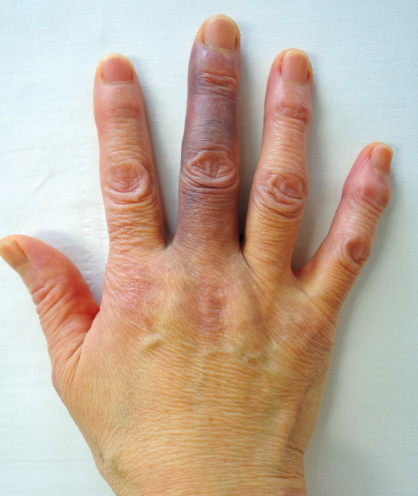Achenbach Syndrome, or Paroxysmal Finger Hematoma, is a condition of unknown etiology characterized by the development of hematomas (spontaneously or after carrying heavy objects or exposure to cold) on the palmar or lateral surface of the fingers. ICD-10 Code: M79.8
It is more common in women than in men, with a ratio of 7:1. The condition can occur at any age, but it peaks around 50 years.
The etiology is unknown. It is believed that the bleeding occurs as a result of pre-existing changes in the blood vessel walls (allergic-hyperergic inflammation, age-related capillary fragility) and concurrent neurovegetative disturbances.
A connection has been found with conditions such as Ehlers-Danlos syndrome, acrocyanosis, gastrointestinal disorders, gallbladder disease, migraine, and systemic lupus erythematosus. Coagulation system parameters are within normal limits.Achenbach syndrome is characterized by the appearance of hematomas, either spontaneously or associated with minor trauma, most commonly on the palmar side of the fingers, although there have been reports of localization on the palm, back of the hand, sole, or toes.
The coin-sized hematoma develops spontaneously or as a result of mechanical stress (carrying grocery bags, typing on a typewriter, exposure to cold) and is accompanied by significant pain. Often, the initial symptom is localized swelling of the affected finger surfaces.
The hematoma resolves within a few days, but frequent recurrences on the same or other hand can be observed.- Acrocyanosis
- Buerger's disease
- Dermatitis artefacta
- Gardner-Diamond syndrome or Psychogenic purpura
- Osler's nodes
- Idiopathic plantar hidradenitis
- Chilblains
- Physical urticaria
- Raynaud's phenomenon
- Trauma

